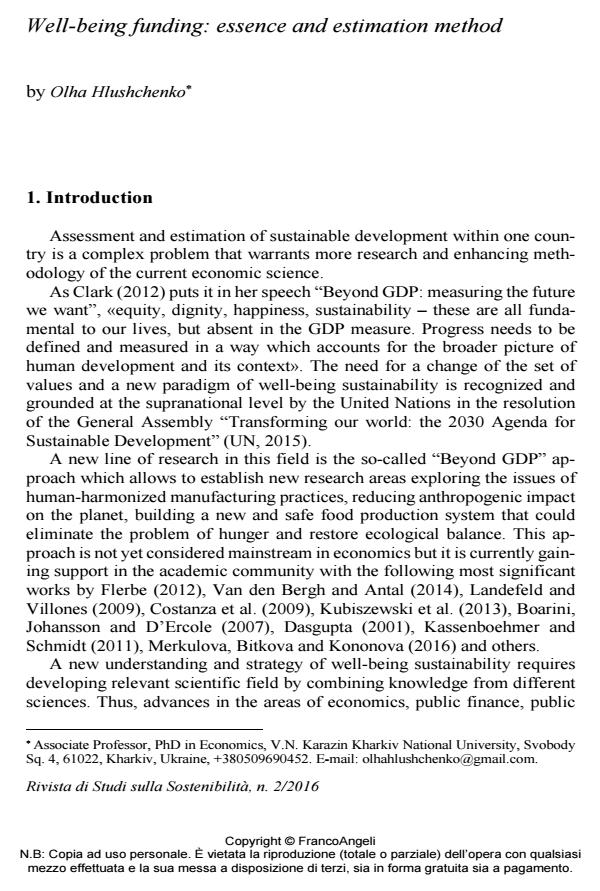Well-being funding: essence and estimation method
Titolo Rivista RIVISTA DI STUDI SULLA SOSTENIBILITA'
Autori/Curatori Olha Hlushchenko
Anno di pubblicazione 2017 Fascicolo 2016/2 Lingua Inglese
Numero pagine 11 P. 45-55 Dimensione file 350 KB
DOI 10.3280/RISS2016-002005
Il DOI è il codice a barre della proprietà intellettuale: per saperne di più
clicca qui
Qui sotto puoi vedere in anteprima la prima pagina di questo articolo.
Se questo articolo ti interessa, lo puoi acquistare (e scaricare in formato pdf) seguendo le facili indicazioni per acquistare il download credit. Acquista Download Credits per scaricare questo Articolo in formato PDF

FrancoAngeli è membro della Publishers International Linking Association, Inc (PILA)associazione indipendente e non profit per facilitare (attraverso i servizi tecnologici implementati da CrossRef.org) l’accesso degli studiosi ai contenuti digitali nelle pubblicazioni professionali e scientifiche
The article focuses on developing new tools to measure sustainable well-being. The main objective is to offer a method for estimating and measuring well-being sustainability and test its results on the actual data from Ukraine. The indicator well-being funding includes the amount of assets funded by public finances for environment protection, health care, spiritual and physical development, education, social protection and financial assets of households. There is a correlation between the amount of financial assets of well-being fund and average life expectancy at birth. There have been defined principles of achieving food security in terms of well-being sustainability.
È messa a fuoco la ricerca degli strumenti della misurazione del benessere stabile. L’obiettivo principale è offrire la metodica del calcolo della misurazione del benessere stabile e testarlo con i materiali di fatto dell’Ucraina. L’indicatore del fondo di benessere comprende le entità di finanziamento assegnate dalle finanze pubbliche per la tutela dell’ambiente, tutela della salute, sviluppo fisico e spirituale, istruzione, difesa e assistenza sociale e anche le risorse finanziarie dei nuclei familiari. Nell’articolo è determinata l’interconnessione tra il volume delle risorse finanziarie di un fondo di benessere e la longevità media aspettata alla nascita. Nel contesto del raggiungimento del benessere stabile sono individuati i principi del raggiungimento della sicurezza alimentare dell’Ucraina.
Keywords:Sicurezza alimentare, risorse finanziarie dei nuclei familiari, finanze pubbliche, benessere stabile, indicatore del fondo di benessere.
- Basu S.R., Fan S., Zhang S. (2007). Welfare comparison beyond GDP: An illustration from China and India. HEI Working Paper, 8: 1-35. Retrieved from https://www.econbiz.de/Record/welfare-comparison-beyond-gdp-an-illustration-from-china-and-india-basu-sudip-ranjan/10003454672.
- Bergh van den J., Antal M. (2014). Evaluating Alternatives to GDP as Measures of Social Welfare/Progress. Working Paper, 56: 1-19.
- Boarini R., Johansson A., d’Ercole M. (2006). Alternative Measures of Well-Being. OECD Social, Employment and Migration. Working Papers, 33: 1-57. DOI: 10.1787/713222332167
- Clark H. (2012). Beyond GDP – Measuring the Future We Want. Retrieved from http://www.undp.org/content/undp/en/home/presscenter/speeches/2012/06/20/helen -clark-beyond-gdp-measuring-the-future-we-want/, June.
- Costanza R.B., Hart M., Posner S., Talberth J. (2009). GDP: The Need for New Measures of Progress. The Pardee Papers, 4: 1-49.
- Dasgupta P. (2001). Human Well-Being and the Natural Environment. Oxford: Oxford University Press.
- Fleurbaey M. (2009). Beyond GDP: The Quest for a Measure of Social Welfare. Journal of Economic Literature, 47(4): 1029-75.
- Jones C.I., Klenow J.J. (2010). Beyond GDP? Welfare across Countries and Time. NBER Working Paper, w16352: 1-42. Retrieved from http://ssrn.com/abstract=1674796.
- Kassenboehmer S.C., Schmidt C.M. (2011). Beyond GDP and back: What Is The Value-Added by Additional Components of Welfare Measurement? Discussion Paper, 8225: 1-29. Retrieved from www.cepr.org/pubs/dps/DP8225.asp.
- Kubiszewski I., Costanza R., Franco C., Lawn P., Talberth J., Jackson T., Aylmer C. (2013). Beyond GDP: Measuring and achieving global genuine progress. Ecological Economics, 93: 57-68.
- Landefeld S.J., Villones S.M. (2009). GDP and Beyond: Measuring Economic Progress and Sustainability. Washington: Bureau of Economic Analysis.
- Merkulova T., Bitkova T., Kononova K. (2016). Tax Factors of Sustainable Development: System Dynamics Approach towards Tax Evasion Analyses. Rivista di Studi sulla Sostenibilità, 1: 35-47.
- State Statistics Service of Ukraine Retrieved from http://www.ukrstat.gov.ua/.
- State Treasury of Ukraine Retrieved from http://www.treasury.gov.ua/main/uk/.
- United Nations (2015). Transforming our world: the 2030 Agenda for Sustainable Development. Retrieved from http://www.un.org/en/ga/search/view_doc. asp?symbol=A/RES/70/1, September 25.
- Methodology for assessing the effectiveness of financing social expenditures considering the risk Nadezhda Yashina, Sergei Nikolaevich Yashin, Elena Poiyushcheva, Nataliya Nikolaevna Pronchatova-Rubtsova, in Тренды и управление /2021 pp.22
DOI: 10.7256/2454-0730.2021.1.26653 - Financial institutions and financial control Andrii Khmelkov, in Ekonomìčna teorìâ /2021 pp.47
DOI: 10.15407/etet2021.02.047
Olha Hlushchenko, Well-being funding: essence and estimation method in "RIVISTA DI STUDI SULLA SOSTENIBILITA'" 2/2016, pp 45-55, DOI: 10.3280/RISS2016-002005